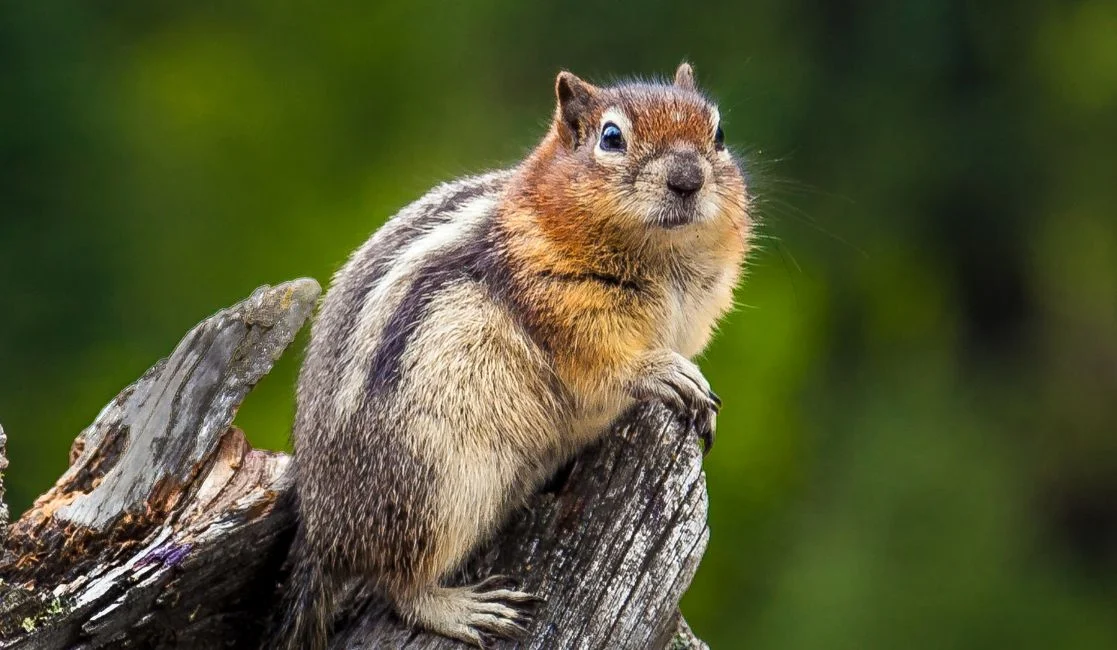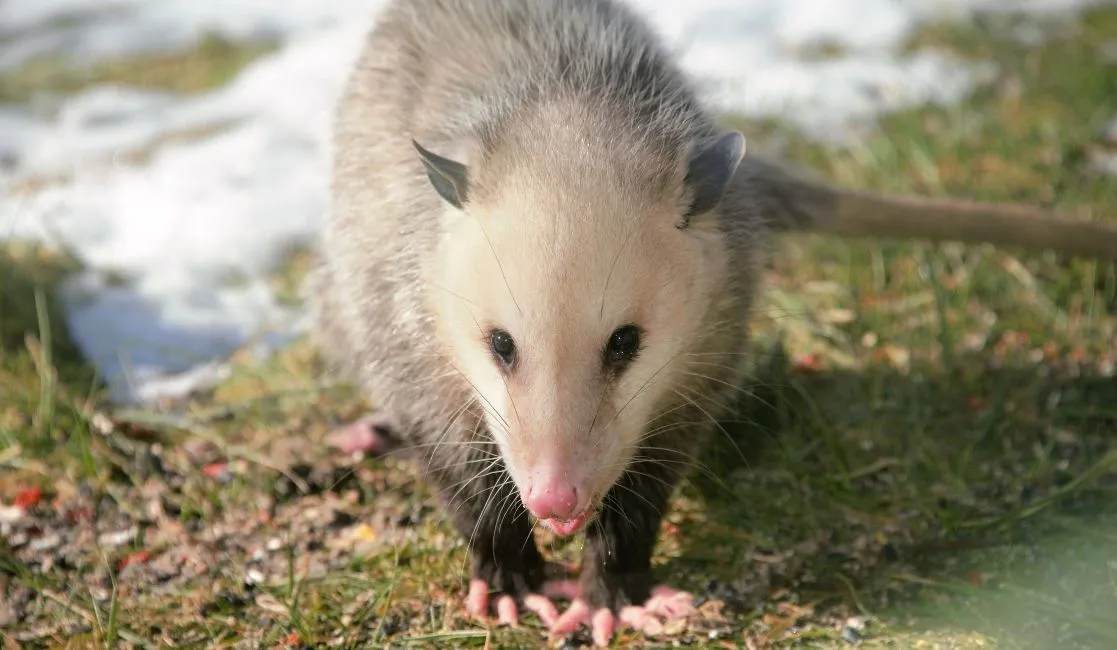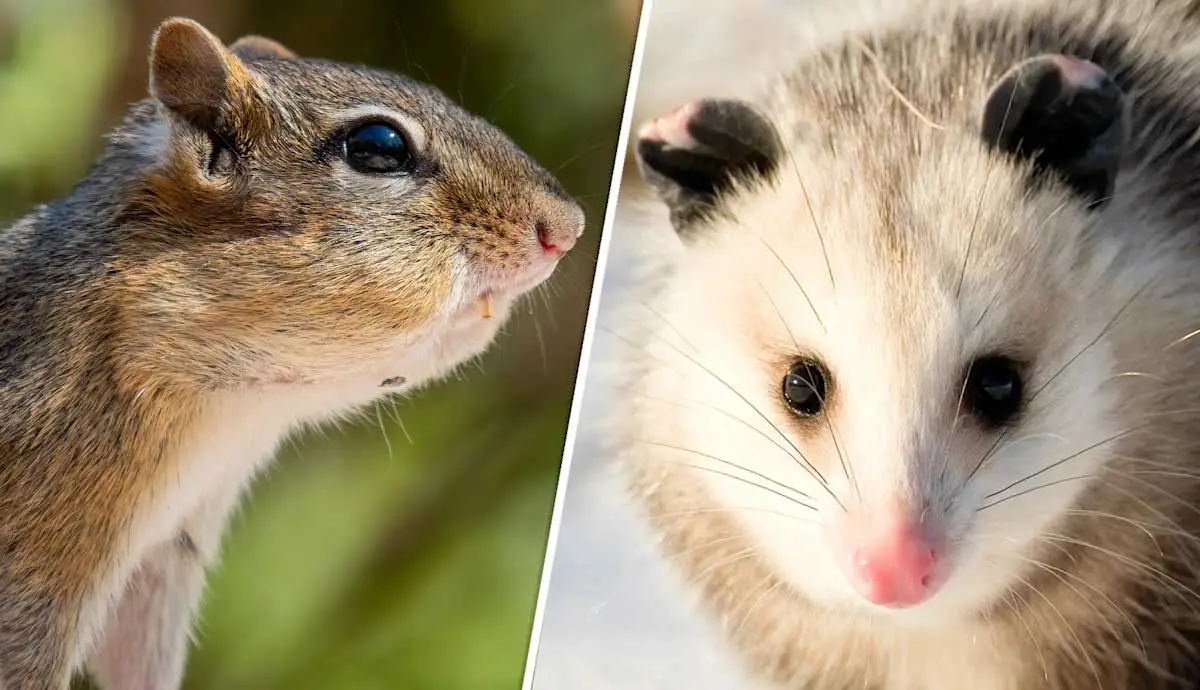Chipmunks Opossum Control Specialist in Durham Region, ON
Chipmunks and Opossum pest control services
Chipmunk wildlife control services

Exclusion and Habitat Modification:
- Identify and seal potential entry points around your property, such as gaps in foundations, vents, or openings in structures.
- Keep areas around bird feeders clean, as spilled birdseed can attract chipmunks.
Trapping:
- Live traps can be used to capture chipmunks. Check local regulations before trapping and releasing wildlife.
- Once captured, relocate chipmunks to a suitable natural habitat away from your property.
Repellents:
- Natural repellents, like predator urine or certain plant-based substances, may deter chipmunks.
- Commercial repellents are also available but should be used according to the product instructions.

Opossum wildlife control services
Exclusion:
- Seal entry points and close off potential hiding spots around your property.
- Secure trash cans to prevent opossums from accessing food sources.
Habitat Modification:
- Remove attractants such as pet food and fallen fruits.
- Trim overgrown vegetation to reduce potential hiding places.
Trapping:
- Live traps can be used for opossums. Check local regulations regarding trapping and relocation.
- Once captured, opossums can be released in a suitable habitat.
Professional Assistance:
- If the situation becomes challenging to handle on your own, consider hiring a professional wildlife control service. Ensure they follow ethical and legal guidelines for humane wildlife removal.
Before taking any wildlife control steps
Local Regulations:
- Check local regulations and laws regarding wildlife control, trapping, and relocation. Different areas may have specific rules to follow.
Humane Practices:
- Prioritize humane and ethical methods for wildlife control. Avoid using poisons, as they can be inhumane and may pose risks to non-target species.
Environmental Impact:
- Choose methods and products that have minimal environmental impact. Consider the potential effects on other wildlife, pets, and the ecosystem.
Consult Professionals:
- If you are unsure about the best approach or if the situation is complex, consider consulting with a wildlife control professional or contacting local wildlife authorities for guidance.
Remember that wildlife plays important roles in ecosystems, and efforts should be made to manage conflicts in a way that respects their role in the environment. Always prioritize solutions that are safe, humane, and compliant with local regulations.

Diseases opossum can spread
Hantavirus:
- Chipmunks can be carriers of hantaviruses, which can cause hantavirus pulmonary syndrome (HPS) in humans. Transmission to humans usually occurs through inhaling dust or droplets contaminated with infected rodent saliva, urine, or feces.
Lyme Disease:
- Chipmunks can harbor ticks, which are vectors for Lyme disease. Ticks pick up the bacteria responsible for Lyme disease (Borrelia burgdorferi) from infected animals, and when these ticks bite humans, they can transmit the bacteria.
Fleas and Other Parasites:
- Chipmunks, like many other rodents, can host fleas and other ectoparasites. While these parasites are not directly transmitted to humans, they may carry diseases or cause discomfort.
Salmonella:
- Chipmunks can carry Salmonella bacteria, which can be transmitted to humans through contact with their feces. Practicing good hygiene, such as washing hands thoroughly after handling chipmunks or their habitats, can help reduce the risk.
Tularemia:
- Tularemia is a bacterial disease that can affect various animals, including rodents. While chipmunks can carry the bacteria, transmission to humans is more commonly associated with handling infected animals, bites from infected ticks or deer flies, or contact with contaminated water or soil.
Diseases opossum can spread
Leptospirosis:
- Opossums may carry the bacteria that cause leptospirosis in their urine. Leptospirosis can be transmitted to humans and other animals through contact with contaminated water or soil.
Tuberculosis:
- While opossums themselves are not significant carriers of tuberculosis, they can potentially contract the disease from other wildlife or domestic animals and serve as hosts.
Tularemia:
- Opossums may be susceptible to tularemia, a bacterial infection. However, they are not considered primary carriers, and the risk of transmission to humans is low.
Internal Parasites:
- Opossums can host internal parasites such as roundworms. While these parasites are generally specific to opossums, there is a risk of transmission to other animals or humans through contact with opossum feces.
External Parasites:
- Opossums can carry external parasites like ticks and fleas. These parasites may transmit diseases such as Lyme disease or flea-borne typhus to other animals or humans.
The nature of chipmunks
Physical Appearance:
- Chipmunks are characterized by their distinctive striped patterns along their back and sides, which helps distinguish them from other rodents.
- They typically have a compact body, short legs, and a bushy tail. The tail is often flattened and furry.
Habitat:
- Chipmunks are native to North America, although some species can be found in Asia.
- They inhabit a variety of environments, including forests, grasslands, gardens, and urban areas. They are adaptable and can thrive in different habitats.
Diet:
- Chipmunks are omnivores, and their diet consists of a variety of foods, including seeds, nuts, fruits, berries, insects, and small vertebrates.
- They have cheek pouches that they use to carry food back to their burrows, where they store it for later consumption.
Behavior:
- Chipmunks are known for their energetic and inquisitive nature. They are often seen darting around, collecting food, and exploring their surroundings.
- They are diurnal, meaning they are most active during the daytime and sleep in their burrows at night.
Burrowing:
- Chipmunks are skilled diggers and create elaborate burrow systems underground. These burrows serve as their homes and provide protection from predators and harsh weather.
- The burrows typically have multiple entrances, as well as chambers for sleeping, storing food, and raising their young.
Reproduction:
- Chipmunks reproduce through sexual reproduction, and females give birth to litters of three to five young, known as pups.
- The breeding season typically occurs in early spring and early summer, and females may have more than one litter per year.
Communication:
- Chipmunks communicate with each other using a combination of vocalizations, such as chirps and squeaks, as well as body language.
Hibernation:
- Chipmunks are not true hibernators, but they do enter a state of torpor during the winter months. They wake up periodically to feed on the stored food in their burrows.
Predators:
- Chipmunks have several natural predators, including birds of prey, snakes, and various mammals. Their cryptic coloration and agility help them evade predators.
The life cycle of chipmunks
Birth:
- Chipmunks typically breed twice a year, with mating occurring in early spring and early summer.
- After a gestation period of about 31 days, female chipmunks give birth to a litter of usually three to five pups. The number of offspring can vary depending on the species and environmental conditions.
Early Development:
- Chipmunk pups are born blind, hairless, and completely dependent on their mother for care.
- The mother nurtures and nurses the pups in the burrow, providing them with her milk for several weeks until they are old enough to start eating solid food.
Weaning and Independence:
- As the chipmunk pups grow, they start to explore their surroundings and learn to forage for food.
- Weaning typically occurs when the pups are around 6 weeks old. At this point, they become more independent, although they may still stay close to the mother.
Juvenile Stage:
- The young chipmunks enter a juvenile stage, during which they continue to develop their skills in foraging, burrow construction, and social interactions.
- They learn from their mother and gain experience in navigating their environment.
Maturity and Reproduction:
- Chipmunks reach sexual maturity at around 10 to 12 weeks of age.
- In their first breeding season, typically occurring in the spring following their birth, they may become parents themselves.
Breeding and Reproduction:
- Adult chipmunks engage in mating rituals during the breeding season.
- After successful mating, the female constructs a nest within the burrow for the upcoming litter.
Burrowing and Storage:
- Chipmunks are skilled burrowers, and they create complex underground systems with multiple entrances and chambers.
- They use their burrows for shelter, protection, and storing food, especially during the winter months.
Winter Behavior (Optional):
- In regions where winters are harsh, chipmunks may enter a state of torpor or partial hibernation to conserve energy. However, they do not undergo a deep and prolonged hibernation like some other rodents.
Life Span:
- The lifespan of a chipmunk varies by species but is generally around 2 to 3 years in the wild. They face various threats, including predation, disease, and environmental factors.
The life cycle of opossum
Birth:
- Opossums are unique among North American mammals because they are marsupials. Females give birth to relatively undeveloped young, called joeys, after a short gestation period of about 12-13 days.
Pouch Stage:
- The newborn opossums are tiny, blind, and hairless. They are about the size of a lima bean and crawl into their mother's pouch, where they attach themselves to one of her 13 teats.
- The joeys stay in the pouch for approximately 60-70 days, during which time they continue to develop and grow. The mother provides them with warmth, protection, and nourishment.
Weaning:
- After spending several weeks in the pouch, the young opossums gradually start to venture out. They cling to the mother's back when not in the pouch and eventually leave it for short periods.
- Weaning begins when the joeys are around 2 to 3 months old. At this stage, they start to eat solid food and rely less on their mother's milk.
Juvenile Stage:
- As the opossums become more independent, they leave the mother's pouch entirely. They continue to stay close to their mother and may ride on her back for some time.
- The juveniles learn essential survival skills during this stage, such as finding food and avoiding predators. Opossums are omnivores, and their diet includes a variety of foods like fruits, insects, small animals, and carrion.
Adulthood:
- Opossums reach sexual maturity at around 6 to 8 months of age. At this point, they leave their mother to establish their territories and find mates.
- The average lifespan of an opossum is relatively short, usually around 1 to 2 years in the wild. They face numerous threats from predators, diseases, and accidents.
Reproduction:
- Once they reach adulthood, opossums engage in mating, and the cycle continues. Mating season typically occurs in late winter and early spring. After successful mating, the female gives birth to a new litter of joeys.






